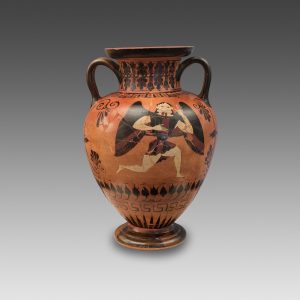Capturing the Beauty of the Brafa Art Fair
The Brafa Art Fair ended last week in Brussels and was a huge success. 132 exhibitors came from 16 different countries to display exquisite antiques, jewelry, art and so much more. With this Virtual Tour, you can get a peek into the layout of our booth from Phoenix Ancient Art and into the meticulous work that went into our preparation for the display.

Neck Amphora – Phoenix Ancient Art
In addition to the video, we’d like to share a glimpse of three pieces of particular interest. Among our many antiques, both from our Phoenix Ancient Art collection and from our Young Collectors’ division, were an Egyptian Wooden Figure, a Cypriot Head and an Attic Amphora.
The amphora is known as a Neck Amphora and the shape is typical for the period from 530-520 B.C. with the echinus mouth, tall neck, deep shoulder and triple handles. The linear elements here were actually incised with a needle and the vessel includes many flower symbols with the lotus blossoms, the red palmettes and more. The main scene is of a running Gorgon in the classic pose of Archaic Greek paintings. The vessel is believed to have been created by the Swing Painter, a Greek artists who was active in Athens during the last part of the 6th century B.C.

Egyptian Wooden Figure : Phoenix Ancient Art
The next piece that was on display is the Egyptian Wooden Figure from the 7th-4th century B.C. The statuette has a rectangular base that is carved in a single piece with the very tip of the left foot. The statue is of a man in a striding pose. His happy facial expression reflects the contemporary Egyptian representations. Typically, these statues would represent a priest or person of high level and even the most modest of tombs included wooden funeral furniture. These figures would be placed in the serdab, which was the area of the tomb reserved for statues of the deceased, and they were another resting place for the person’s spirit in case the physical body was damaged. This practice was done from the late Old Kingdom until the 2nd millennium.
Finally, the third piece under discussion is the Cypriot Head from the late 7th to early 6th century B.C. This head depicts a middle-aged man wearing a conical helmet and facial characteristics that are typical of Archaic Cypriot sculptures. These sculptures started to develop in the 7th century and were made, almost exclusively, out of limestone since there was no marble available on the island. Typically, this art would be depicted by life-size male and female figures and they were most often found in the island’s shrines.
These are three examples of the rich historical legacy that we displayed at the Brafa Art Fair and that can be enjoyed with this three dimensional, interactive video. Next, we are getting ready for our show in Gstaad from February 20-25 and we hope to see you there!